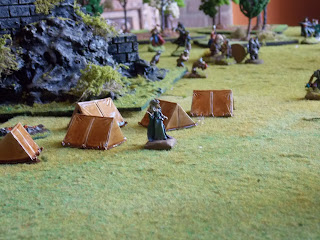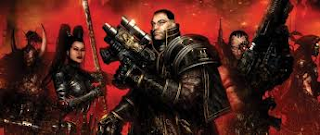We thought this battle quite some time ago, but I've only just got round to writing it up. It is the third instalment in a (very slow burning) Middle Earth campaign. The scenario rules can be found here.
I was playing the defending bad guys, who were positioned in the centre of the table, around the central tower (Minas Urgal, or Ergal, translation issue and nothing to do with me forgetting the name, honest guv), they couldn't move until the alarm had been raised by one of my four sentries. The sentries could move but only in a pre-planned way.
After moaning that the scenario was biased against him Edward completely forsook the element of surprise and just rushed the camp. Above his troops can be seen emerging from the woods.
Above, The camp. A group of wildmen are clustered near the base of Minas Urgal, the Black Numenorean Sorceress is near the tents and a sentry wonders past on guard duty.
Above, The Black Numenorean was the focal point of the game, if she stayed alive then the bad guys won, if she was taken out of action the good guys won. Here she is keeping her distance and wishing she'd chosen her spells more wisely as a fray breaks out in the distance.
Above, an overview of the battle field.
Most of the battle centred around one complicated combat. I tried to tie up as many of the attackers as I could, in an attempt to stop them getting to the sorceress who was powerful with spells, but awful in combat.
This was the first time we'd used the Advanced version of the Song of Blades and Heroes rules. The reaction rule really made this tense: one slip up from the attackers was enough for me to react and hold get another defender into combat.
In the end I got the Black Numenorean too close, Edward got an archer free from combat and took her out of action, thus winning the battle. Afterwards she was rolled for and deemed to have survived, so the fight goes on.
Nest time we will be playing another version of this scenario but reversing the rolls, the bad guys will be creeping into town to take out an important good guy.








































